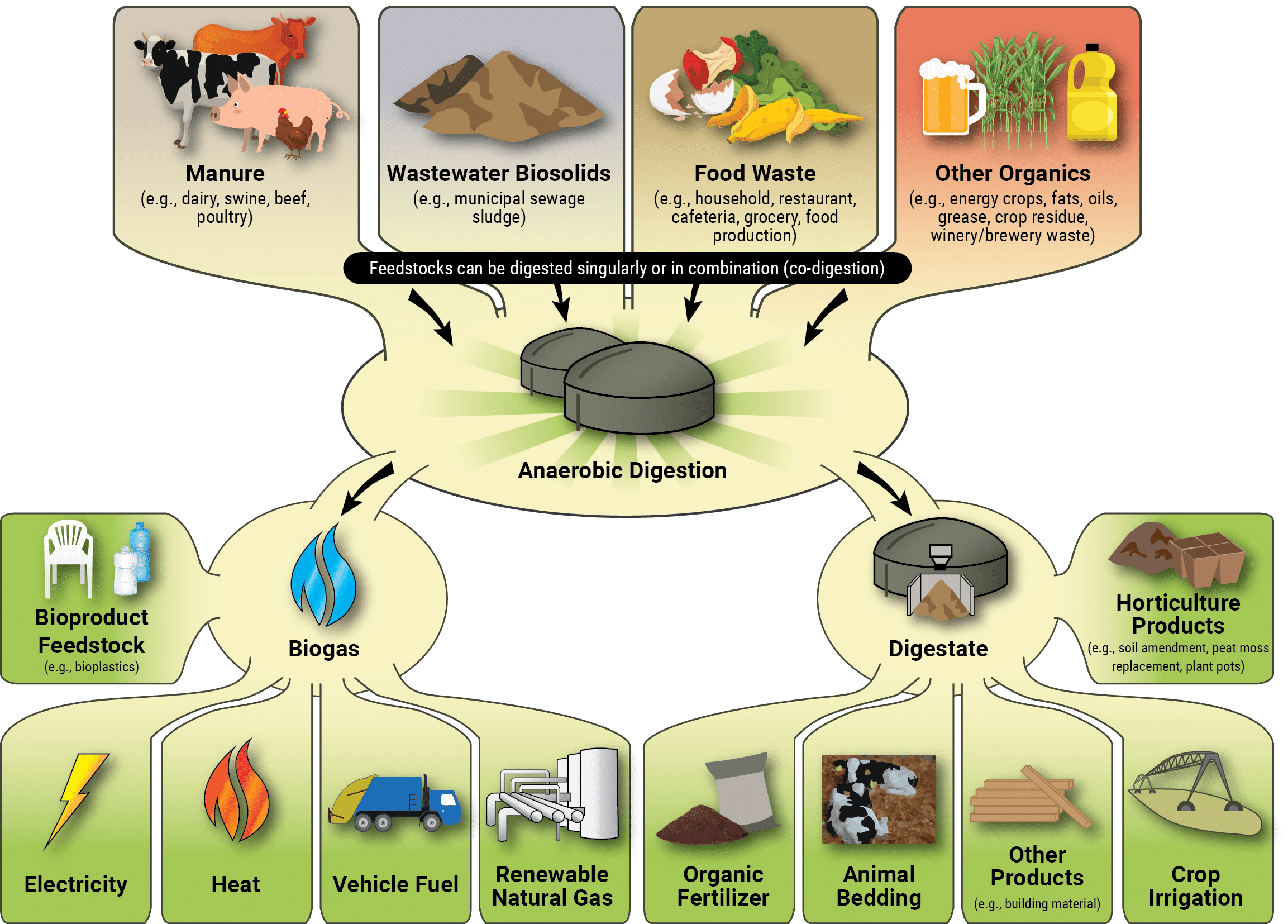Methane is estimated to be responsible for 30% of global warming and today’s concentration of this potent greenhouse gas in the atmosphere is the highest in the last 800,000 years. While countries around the world are thinking of ways to mitigate the impacts of this gas, methane can actually be used in a more beneficial way by turning it into renewable energy through a process called anaerobic digestion.
—
What is Anaerobic Digestion?
Anaerobic digestion is the process where microorganisms break down organic materials – such as food waste, organic waste, sewage sludge, and animal manure – in an enclosed, oxygen-free container, which is also known as reactors or anaerobic digesters. The broken-down matter results in two products: Biogas, a renewable source of methane gas, and digestate, the remaining organic material. Anaerobic digesters come in various designs, sizes, and types, depending on location, cost, operation temperature, and what material is being processed. Still, all digesters have the same basic purpose: optimising waste.

Anaerobic digestion system. Graph: US Environmental Protection Agency (EPA)
Biogas, which contains roughly 45% to 75% of methane, can be directly used as a renewable energy source to provide industries and homes with electricity and heat, as well as generate fuel for transportation. Biogas can also be purified into renewable natural gas, or, in other words, biomethane, which is carbon neutral and interchangeable with natural gas and can be used for natural gas pipelines and transportation.
Digestate contains solid and liquid materials possessing beneficial nutrients, minerals, and water which can be utilised in various manners, such as nutrients for soil amendment, livestock bedding, fertiliser, and a basis when creating bioplastics.
Putting Methane Into Use
One way methane is produced is from decaying organic matter in environments without oxygen, such as wetlands and landfills. However, an anaerobic digester can capture and optimise methane released from the breakdown of these matters and transform it into biogas, while the excess product from the processed waste becomes digestate.
Livestock manure largely contributes to human-made methane emissions, especially when discarded and stored in piles and lagoons. Including enteric fermentation (when microbes break down food present in an animal’s digestive tract), livestock manure represents 32% of overall methane emissions. Instead of disposing manure off to the side, livestock farms can recycle it with an anaerobic digester, creating useful solid and liquid nutrient-rich end-products for the farm, animal bedding, and fertiliser, along with generating renewable methane energy.

Using biogas produced from manure-based anaerobic digesters. Graph: US Environmental Protection Agency (EPA)
Food and organic waste that make up many of today’s landfills also contribute to methane production, emitting this potent greenhouse gas in the same manner as livestock manure. Food waste alone is responsible for 8% to 10% of global emissions, including methane and other greenhouse gases; however, anaerobic digestion can take food and organic waste and convert these environmentally detrimental materials into beneficial products.
Specifically, an anaerobic digester can produce a year-worth of renewable methane energy to supply 800 to 1,400 homes if 100 tons of food waste are processed daily. Putting that into example, about 103 million tons of food are wasted in a year in the US. This means that in one day, there are roughly 280,000 tons of food waste, which if processed through an anaerobic digester, can power approximately 2,800 homes.
You might also like: What Are the Major Sources of Methane in the Atmosphere?
What Is in Store for Today’s World?
Anaerobic digestion is currently implemented in both urban and rural sites across the world to lower the amount of methane and other greenhouse gases released into the atmosphere, with countries like China, India, and Bangladesh creating plans to implement micro-scale anaerobic digestion systems in rural areas. Other countries like Germany have renewable energy policies in place, like putting a special tariff for energy generated from manure-based anaerobic digesters.
At a global scale, there are approximately 50 million micro-scale anaerobic digesters and 132,000 small, medium, and large-scale digesters.
The United States alone has about 2,300 anaerobic digesters. Around 331 of these digesters are manure-based and are mainly found in dairy, pig, poultry, and beef farms. In 2015, Europe had 17,400 anaerobic digesters, generating 18 billion cubic metres of renewable methane gas, or, to put it differently, 18 trillion litres of biogas. Today, Germany has almost 10,000 anaerobic digesters, generating enough fuel for some communities in the country to basically become fossil fuel free.

The Fremont Regional Digester found in Michigan, the US processes food and organic waste. Photo: Fremont Regional Digester
The outlook of using anaerobic digesters looks promising.
According to a 2019 report published by the World Biogas Association, anaerobic digestion is able to reduce the current atmospheric greenhouse gas emissions, including methane, by 10% to 13%. Despite this favourable statistic, countries worldwide are only tapping into 1.6% to 2.2% of the potential that anaerobic digestion systems have for mitigating greenhouse gas emissions. The report concluded that “the potential for the growth of the biogas industry is therefore extraordinary and involves every country.”
In order to effectively mitigate global warming, it is critical to use more sustainable and greener practices worldwide. Anaerobic digestion does not just reduce global greenhouse gas emissions but also efficiently uses waste and methane production and converts these harmful products into valuable, renewable energy.
Featured image by Matti Blume/Wikimedia Commons
You might also like: The Importance of Addressing Planet-Warming Methane Emissions in the Energy Sector


















